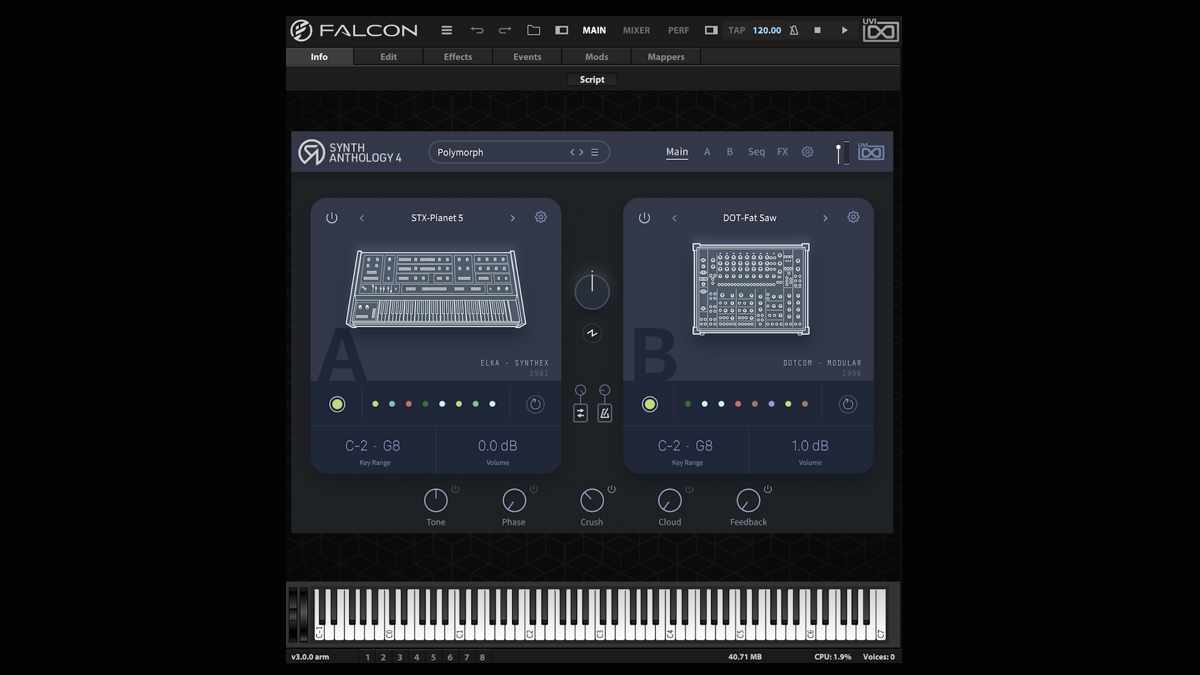In This Issue
UVI Synth Anthology 4 for UVI’s Falcon and Workstation: the Synth and Software Review

Not emulations, but rather unique sounds with their own quirks
It’s been said: “You can’t have everything; where would you put it?” The folks at UVI have narrowed the focus of that goal to synthesizers, and even so, the task remains quixotic.
Let’s set our expectations straight: considering the vast number of synthesizers manufactured over the years, you would need a massive number of different engines to get the job done. Synth Anthology 4 (SA4) is a sample library, coupled with a subtractive engine and a decent set of modulation utilities.

Nonetheless, a sampler is not an Oberheim Expander or a Yamaha FS1R. So rather than attempting strict reconstructions of these instruments, UVI has created a unique, expressive, and satisfying library of sounds capturing the flavor of a slew of instruments, familiar and obscure, vintage and contemporary.
As the fourth package in the series, SA4 takes a different tack from its antecedents. For the most part, the patches comprise two layered synthesizer patches, labeled A and B. Each patch is presumably programmed to impart distinctive characteristics of a single-source device (Access Virus C, Kawai K5000, Korg Wavestate, Studiologic Sledge, to name a few).
So vector-oriented synth patches sweep through multiple sonorities; additive synths capture that characteristically glassy perfection, sounds overlaid with swirling harmonics are well-represented, and so on. The result of all of this is an often-brilliant mating of sounds into something far cooler than the sum of its parts.
There’s a reasonable amount of customization under the SA4 hood. For starters, every layer is accompanied by row of eight color-coded buttons. Clicking on one loads an alternate patch that sits well with the other – if a patch is monophonic, for example, the next choice will follow suit. If you need something different, a button to the right offers additional compatible choices. You can create splits by dragging on the pitches listed under each layer.
The motion
Although SA4 isn’t a full-blown vector synthesizer, there are a few handy crossfade tools between the A and B patches. You can set the crossfade rate, bias, and range; the LFO shape that drives the crossfade; sync-to-tempo; and even invert the LFO. The majority of layers already have some form of motion, so animation can range from subtle to dramatic to downright silly.
SA4 features a modest but decently-appointed subtractive engine, with a choice of filters: Expander, VCF20, or Comb. The first two are modeled after classic analog synths.

Among other nice refinements, you can add curvature to the attack and decay slopes to the amplitude and filter ADSR envelopes. The A and B patches share a pair of LFOs, also labeled A and B, which can be confusing, as they aren’t dedicated to a layer.
LFO A offers a choice of sine, triangle, saw, ramp, and what appears to be noise (the manual doesn’t name any of the shapes). LFO B offers Sine, Saw, Ramp, triangle, LFOs with different pulse widths and other interesting shapes and curvatures, which, among other features offers adjustable randomization and smoothing.

UVI’s flexible and powerful step sequencer and arpeggiator section offers independent sections per layer, generating intriguing rhythmic motion. A stroll through the instrument’s Arpeggiated and Pulses banks demonstrate some intriguing rhythmic possibilities.
I’d be remiss not to mention the bank of patches contributed by Venus Theory, which are cinematic and exceptional. The Machines folder holds a staggering array of single, unlayered patches from every instrument used in the making of the library – a great place to start if you want to build your own sounds and customize your performance.

Although Falcon and UVI Workstation have had MPE compatibility for some time, you had to dig for it. Adding a top-level MPE menu button to the SA4 menu is a welcome feature that saves a fair amount of menu diving.
I started this review expecting a workaday assortment of wannabe synth emulations. Instead I found a treasure trove of sounds whose strengths and quirks often interacted in strange, and most often inspiring ways.
Lesson learned – which I’m happy to pass on: if you approach Synth Anthology 4 with the expectation of replacing a warehouse full of hardware synthesizers, you’ll be let down. If you take the instrument on its own terms, you’ll find a monstrous confluence of superbly animated synthesizer sounds to grace your arrangements. Highly recommended.
Price: $149
















